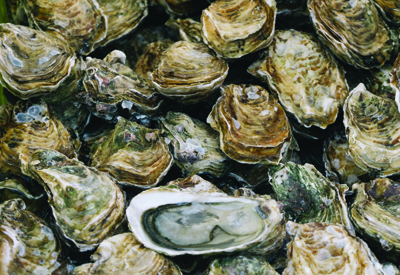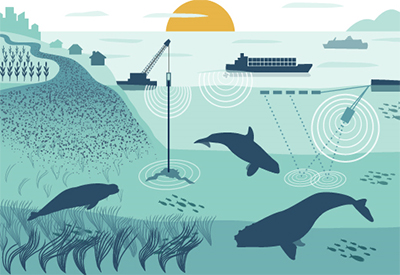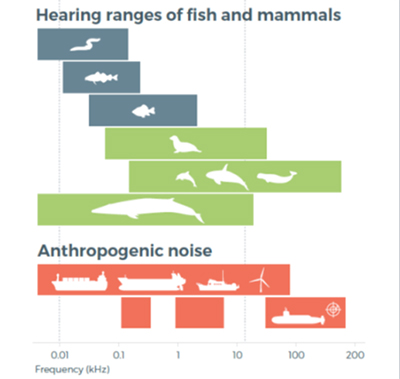A Noisy Noise Annoys an Oyster

Sept 22, 2022
Aaron Purdy – Ocean Wise
A noisy neighbour is never nice. Many of us have been bothered by another boater blasting their music in a quiet bay. For wildlife, however, noise isn’t simply a nuisance. Studies have shown that human-caused sound can disrupt natural behaviours, destroy habitat, alter physiology, and in extreme cases even result in death. We want to be considerate of noise to avoid impacting our neighbors, and that applies to those below the surface of the water as well. Knowing how underwater noise is generated, how it affects wildlife, and how you can help reduce your impact will help make you a more responsible boater and make sure you are minimizing your impact on the environment.
 Anthropogenic, or human-caused noise, is produced in all sorts of places, and affects all types of wildlife beneath the waves. Image courtesy of Fisheries and Oceans Canada.
Anthropogenic, or human-caused noise, is produced in all sorts of places, and affects all types of wildlife beneath the waves. Image courtesy of Fisheries and Oceans Canada.
Anthropogenic, or human-caused, noise is increasingly recognized as an important source of pollution in oceans and waterways across the world. We produce sound from a variety of locations, but the most prominent noise comes from sources like seismic surveys, sonar, construction, underwater mining, and of course commercial and recreational vessels. These sounds cover a wide range of frequencies, meaning many different types of wildlife will be able to hear us, no matter what they can detect. Additionally, anthropogenic noise is increasing worldwide, meaning that it is getting harder for wildlife to avoid the noisy neighbours upstairs.
 Range and frequency typically heard and produced by marine fish (blue blocks) and marine mammals (green blocks), compared to the range of frequency typically produced by certain human activities on the oceans (red blocks). Image courtesy of Ocean Wise.
Range and frequency typically heard and produced by marine fish (blue blocks) and marine mammals (green blocks), compared to the range of frequency typically produced by certain human activities on the oceans (red blocks). Image courtesy of Ocean Wise.
Marine mammals in particular are impacted by increasing noise underwater. Many whale species use sound to explore their environment via echolocation and communicate over long distances. When these calls are masked by excess sound, it can hinder the animals’ ability to find food, travel, or complete other important behaviours such as communicating or feeding their young. In extreme cases, whales have been known to beach themselves after suffering internal damage from sound pulses caused by seismic surveys or sonar.
The effects of noise extend beyond whales – many fish and invertebrates are affected behaviourally, and even physically, by underwater noise. Pacific oysters decrease their feeding rate in response to sounds of shipping traffic, limiting their ability to grow effectively. Blue mussels that were experimentally subjected to ship noise even showed significant damage to their DNA, a by-product of increased stress. For fish, exposure to underwater noise increases stress levels and impacts their ability to forage and detect predators.
It is important to note that the largest contributors to anthropogenic noise are not recreational boaters. Commercial vessels, underwater mining, and seismic surveys all produce sounds that are louder and propagate over longer distances than an average motor vessel. However, this doesn’t mean that recreational boats can’t have a negative impact on the environment. A recent study found that anthropogenic noise from recreational vessels dominate the underwater soundscape in coastal environments and wildlife shows clear signs of impact from nearby boats. Killer whale foraging behaviour is altered by the presence of nearby vessels, resulting in an estimated 18% decrease in energy uptake. Both freshwater and saltwater fish are also known to avoid areas frequented by recreational boats. Cichlid fish for instance prefer quiet mating areas over those exposed to recreational boater noise. While individual vessels may not have a large impact, it is important to recognize the cumulative effect multiple boats can have on local wildlife.
So how can you ensure you are minimizing your sound footprint on the environment? First is knowing your route and ensuring your avoiding environmentally sensitive areas. If you are in the vicinity of wildlife, particularly around whales, dolphins, and porpoises, slowing your speed will greatly reduce the noise your vessel is putting into the environment. Contributing to local wildlife surveys during your boating activities can also help researchers know where at-risk species are found to help people avoid those areas. Proper maintenance of your hull and propeller can also decrease your vessel’s noise. Fouling can increase cavitation which can account for 80-85% of the noise from a ship. Finally, avoid contributing to large-scale marine traffic by reducing unnecessary consumption and buying local products. And remember, while a noisy noise annoys an oyster, a brainy boater may abate those blues.
For more information on underwater noise check out these resources:
Fisheries and Oceans Canada
Port of Vancouver’s ECHO Program




























